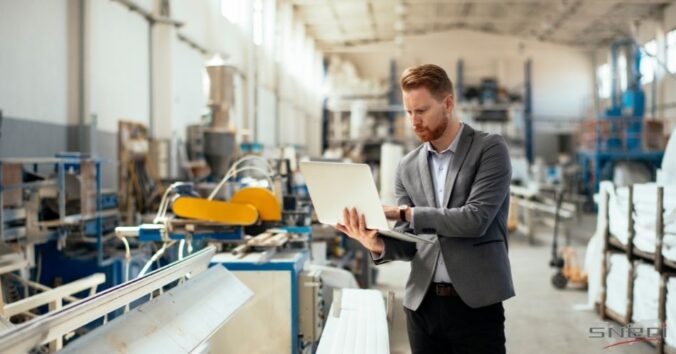The 5S method: ideal to reach operational excellence

We talked to you about Lean Manufacturing and the different tools that allow to increase the industrial performance in order to reach the 5 Zeros: Zero delay, Zero stock, Zero paper, Zero defects and Zero breakdown. Today, we zoom in on one of the Lean Manufacturing tools, namely the 5S method.
Method 5S : definition
There are several ways to optimize and improve industrial performance. Among them, we find the 5S method.
Originating from Japan, the 5S method is a work organization method and a management technique that is part of a quality approach. Coming straight from Japan, this tool was developed by the Toyota group as part of the TPS (Toyota Production System) in the 1950s.
Its implementation was initially for Toyota production workshops, but today it is applied to all work areas.
The 5S method aims to gain in productivity while improving the working conditions of employees. Organization and safety are indeed the watchwords of this method.
The meaning of 5S
The 5S correspond to 5 Japanese action verbs to guide us to have an organized, safe, clean, tidy work environment…
1st S: SEIRI (整理) = TO CLEAR
This first step gets rid of everything that is unnecessary and/or cumbersome. It consists of sorting out the items we need and those we no longer need (equipment, tools…). It will be a question of putting aside the superfluous in order to keep only the essential resources, those which we really have the utility.
This action therefore requires a certain ability to project oneself into the future.
2nd S: SEITON (整頓) = TO TIDY
This second step consists in tidying up the workspace, once we have got rid of the useless elements. It is therefore an essential action. More precisely, it consists in putting order in our workspace so that we can find things quickly and easily when we need them. This will avoid wasting time looking for important elements for long minutes. The goal is to assign a defined place to each thing by facilitating its use.
Beyond simple storage, the “Seiton” also encourages making the tools used by employees on a daily basis more accessible, closer, with a view to improving productivity. Thus, it will become easier to make people progress on their different jobs, at work.
3rd S: SEISO (清掃) = CLEAN UP
Although it may seem tedious to some, this step is essential. It consists of cleaning your work environment (tools, machines, offices…) and maintaining good hygiene.
In addition to having a clean working environment, this action also allows the detection of possible anomalies and/or malfunctions in the material used in the workplace. This third action therefore reduces the risk of equipment breakdowns and related incidents (work stoppages avoided).
A good (regular) cleaning makes it possible to identify (and thus to rectify in time) the wear and tear that appears on the machines/tools in a premature way. This allows a financial gain because the material can be repaired instead of being repurchased (which can be expensive).
4th S: SEIKETSU (清潔) = TO STANDARDISE
This standardization step is about defining the rules that will keep the workplace clean, tidy, safe and secure. It will therefore be a matter of anchoring this new order in the minds of the employees and encouraging them to become familiar with the new procedures introduced. The goal is also to prevent bad habits from taking over.
Indeed, in order to facilitate the respect of these methods by the people, it will also be necessary to think of setting up a certain number of procedures (example: written document posted in the workplace, internal newsletter reminding the good practices to be followed…). The manager(s) of the company/plant must therefore make sure to set up an organization that will avoid the risks of disorder.
5th S: SHITSUKE (躾) = TO FOLLOW
This step consists of following the rules set up previously (elimination, tidying, cleaning and standardization: 4S). Therefore, a way must be found for employees to adhere to the new work system. The objective is to maintain a healthy, tidy and safe working environment for everyone in the long term.
It is therefore necessary to involve the employees (as project leaders) and then to carry out frequent checks to ensure that the rules are being followed. This will also enable the detection of the most relevant rules and those that are less relevant in operational terms. The “shitsuke” therefore implies being in a continuous improvement process for a better working environment.
The advantages of the 5S method
The main objective of this method is to have a safe, tidy and healthy work environment that is conducive to productivity.
Applying the 5S method to a construction site has many advantages since this management technique allows to avoid work accidents, to improve the working conditions, to reduce the losses of materials and documents but also to make the collaborators responsible.
Moreover, setting up a 5S worksite also allows to better control the budget of the worksite, to respect the deadlines more easily and to improve the quality of the works.
A 5S worksite is therefore synonymous with productivity gains for the company, regardless of the sector of activity, while guaranteeing the safety and satisfaction of employees.
Thus, through this method, teams realize that progress is only really possible if everyone “gets involved” through the collective and individual commitment of each employee.
The 5S method makes it possible to make each person responsible by encouraging them to improve their work environment, and this in the long term, including the management, which must be the first to instill this impetus for change by establishing a participative management method that allows all the people in the company to be involved.
In terms of benefits, these are numerous.
In terms of productivity:
– Workstation more organized, tidy, safe, clean
– More protected equipment: regular checks and cleaning of the equipment limit the risk of breakdowns, wear and tear…
– Reduced risk of work-related accidents: a safer environment reduces possible dangers in the workplace
– Optimization of resources and reduction of waste: this method promotes the efficient and safe use of available resources, which also reduces unnecessary use
– Promotes a “collective” feeling in the workplace: by encouraging everyone to get involved
– Improved working conditions at all levels
An employee equipped in a secure environment and involved in his or her duties will increase productivity.
In terms of organization and life skills
– Promotes compliance with new rules and commitments
– Optimization of employees’ skills and know-how
– Encourages the emergence of new ideas (new processes, new work methods, etc.) and thus promotes creativity
– Fosters a collective commitment: feeling of cohesion reinforced between the different hierarchical levels
– Promotes the adoption of best practices and the abandonment of bad habits
A committed and involved employee will be more inclined to follow processes, especially if they are consulted beforehand and if they are properly explained to them.
SNECI guides you towards operational excellence with the 5S method
With 70 years of expertise in the industry, particularly through automotive excellence, our industrial performance division assists companies in two aspects of the 5S project. On the one hand, the support and implementation of a 5S work site and, on the other hand, the 5S training.
Within the framework of our accompaniment to the installation of a 5S work site, several stages will have to be respected:
- Upstream: we make sure that a person in charge of the site is defined beforehand. This is usually a person you trust, who communicates easily with the teams and who has leadership skills.
- Always upstream before you launch, we accompany you in the preparatory phase, i.e. in the determination of the scope of the project and the allocated budget. Note that it is essential to establish a schedule.
- We accompany you in the inventory of your site in order to identify all the parts of your activity that need to be analyzed and improved
- Key moment of the implementation of a 5S project before starting: the presentation to the teams allowing to serve as a reference.
- Team training: so that everyone can apply it correctly. Training sessions must therefore be organized. The teams must find meaning in it and therefore understand the advantages of this work organization.
- Implementation of the convergence plan decided beforehand
- Reporting and assessment of the 5S method.
SNECI offers a training course that will enable you to familiarize yourself with the 5S method and to better understand its application on a pilot project during a workshop with your teams. You will then have all the keys in hand to have a safe, healthy, clean and tidy working environment thanks to the 5S method. On the program of this training :
- Presentation of the 5S approach
- Description of the 5 phases
- Visual management
- Description of site animation
- Key success factors to maintain 5S results and implement continuous improvement
- 5S worksite on a pilot project in a work area of your choice
- Action plan with the remaining tasks to be executed in the pilot project
Adopting the 5S method on your sites will allow you to improve your performance as well as the working conditions of your employees, so if you wish to know more about the 5S method or if you wish that our teams accompany you on the subject, send an email to Laura (who commits herself to answer you within 24 hours) at laura@sneci.com or contact us directly on our website






